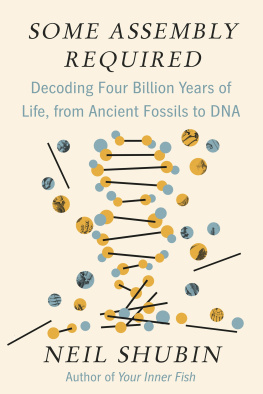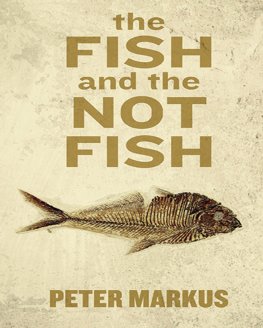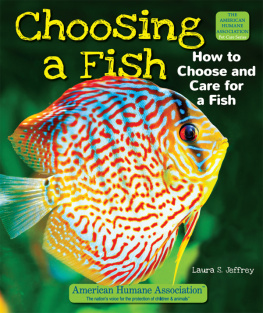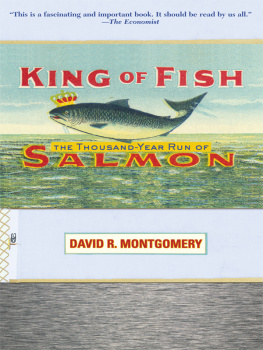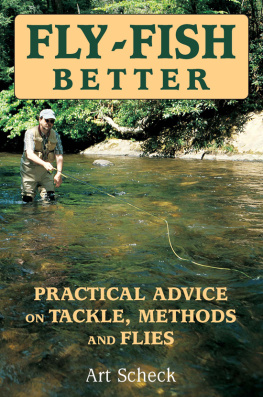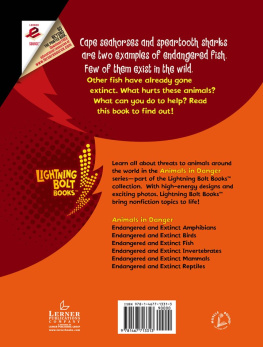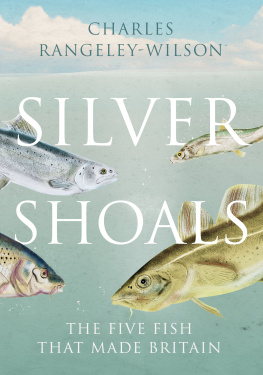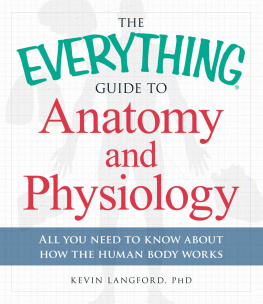
CONTENTS

TO MICHELE
PREFACE

This book grew out of an extraordinary circumstance in my life. On account of faculty departures, I ended up directing the human anatomy course at the medical school of the University of Chicago. Anatomy is the course during which nervous first-year medical students dissect human cadavers while learning the names and organization of most of the organs, holes, nerves, and vessels in the body. This is their grand entrance to the world of medicine, a formative experience on their path to becoming physicians. At first glance, you couldnt have imagined a worse candidate for the job of training the next generation of doctors: Im a paleontologist who has spent most of his career working on fish.
It turns out that being a paleontologist is a huge advantage in teaching human anatomy. Why? The best road maps to human bodies lie in the bodies of other animals. The simplest way to teach students the nerves in the human head is to show them the state of affairs in sharks. The easiest road map to their limbs lies in fish. Reptiles are a real help with the structure of the brain. The reason is that the bodies of these creatures are often simpler versions of ours.
During the summer of my second year leading the course, working in the Arctic, my colleagues and I discovered fossil fish that gave us powerful new insights into the invasion of land by fish over 375 million years ago. That discovery and my foray into teaching human anatomy led me to explore a profound connection. That exploration became this book.
CHAPTER ONE

FINDING YOUR INNER FISH
T ypical summers of my adult life are spent in snow and sleet, cracking rocks on cliffs well north of the Arctic Circle. Most of the time I freeze, get blisters, and find absolutely nothing. But if I have any luck, I find ancient fish bones. That may not sound like buried treasure to most people, but to me it is more valuable than gold.
Ancient fish bones can be a path to knowledge about who we are and how we got that way. We learn about our own bodies in seemingly bizarre places, ranging from the fossils of worms and fish recovered from rocks from around the world to the DNA in virtually every animal alive on earth today. But that does not explain my confidence about why skeletal remains from the pastand the remains of fish, no lessoffer clues about the fundamental structure of our bodies.
How can we visualize events that happened millions and, in many cases, billions of years ago? Unfortunately, there were no eyewitnesses; none of us was around. In fact, nothing that talks or has a mouth or even a head was around for most of this time. Even worse, the animals that existed back then have been dead and buried for so long their bodies are only rarely preserved. If you consider that over 99 percent of all species that ever lived are now extinct, that only a very small fraction are preserved as fossils, and that an even smaller fraction still are ever found, then any attempt to see our past seems doomed from the start.
DIGGING FOSSILSSEEING OURSELVES

I first saw one of our inner fish on a snowy July afternoon while studying 375-million-year-old rocks on Ellesmere Island, at a latitude about 80 degrees north. My colleagues and I had traveled up to this desolate part of the world to try to discover one of the key stages in the shift from fish to land-living animals. Sticking out of the rocks was the snout of a fish. And not just any fish: a fish with a flat head. Once we saw the flat head we knew we were on to something. If more of this skeleton were found inside the cliff, it would reveal the early stages in the history of our skull, our neck, even our limbs.
What did a flat head tell me about the shift from sea to land? More relevant to my personal safety and comfort, why was I in the Arctic and not in Hawaii? The answers to these questions lie in the story of how we find fossils and how we use them to decipher our own past.
Fossils are one of the major lines of evidence that we use to understand ourselves. (Genes and embryos are others, which I will discuss later.) Most people do not know that finding fossils is something we can often do with surprising precision and predictability. We work at home to maximize our chances of success in the field. Then we let luck take over.
The paradoxical relationship between planning and chance is best described by Dwight D. Eisenhowers famous remark about warfare: In preparing for battle, I have found that planning is essential, but plans are useless. This captures field paleontology in a nutshell. We make all kinds of plans to get us to promising fossil sites. Once were there, the entire field plan may be thrown out the window. Facts on the ground can change our best-laid plans.
Yet we can design expeditions to answer specific scientific questions. Using a few simple ideas, which Ill talk about below, we can predict where important fossils might be found. Of course, we are not successful 100 percent of the time, but we strike it rich often enough to make things interesting. I have made a career out of doing just that: finding early mammals to answer questions of mammal origins, the earliest frogs to answer questions of frog origins, and some of the earliest limbed animals to understand the origins of land-living animals.
In many ways, field paleontologists have a significantly easier time finding new sites today than we ever did before. We know more about the geology of local areas, thanks to the geological exploration undertaken by local governments and oil and gas companies. The Internet gives us rapid access to maps, survey information, and aerial photos. I can even scan your backyard for promising fossil sites right from my laptop. To top it off, imaging and radiographic devices can see through some kinds of rock and allow us to visualize the bones inside.
Despite these advances, the hunt for the important fossils is much what it was a hundred years ago. Paleontologists still need to look at rockliterally to crawl over itand the fossils within must often be removed by hand. So many decisions need to be made when prospecting for and removing fossil bone that these processes are difficult to automate. Besides, looking at a monitor screen to find fossils would never be nearly as much fun as actually digging for them.
What makes this tricky is that fossil sites are rare. To maximize our odds of success, we look for the convergence of three things. We look for places that have rocks of the right age, rocks of the right type to preserve fossils, and rocks that are exposed at the surface. There is another factor: serendipity. That I will show by example.
Our example will show us one of the great transitions in the history of life: the invasion of land by fish. For billions of years, all life lived only in water. Then, as of about 365 million years ago, creatures also inhabited land. Life in these two environments is radically different. Breathing in water requires very different organs than breathing in air. The same is true for excretion, feeding, and moving about. A whole new kind of body had to arise. At first glance, the divide between the two environments appears almost unbridgeable. But everything changes when we look at the evidence; what looks impossible actually happened.
Next page

